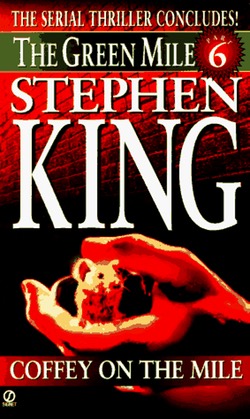In November, 1995, it was announced that Stephen King wouldn’t just release one book in 1996, he would release eight. Two were scheduled for the same day in September (Desperation and The Regulators) and six would be serialized installments of The Green Mile, released once a month in 100 page chapbooks by Signet from March through August. Comparisons to Charles Dickens abounded, booksellers worried about what would happen if people lost interest after the first volume (not to worry—at one point, all six books were simultaneously on the New York Times bestseller list), Pocket Books stole the idea for three of their VC Andrews series, John Saul swiped the idea for his Blackstone Chronicles, and the eventual 1999 movie adaptation remains the highest-grossing Stephen King adaptation of all time, earning nearly twice as much as the runner-up.
But even though it’s lumped in with his more critically-acclaimed realistic novels like “The Body,” Hearts in Atlantis, and Misery, The Green Mile is usually considered second-tier. It’s too sentimental, its symbolism is too on-the-nose, it’s got a Magical Negro at the center, and any way you slice it, a book set in 1932 featuring an intelligent mouse, an enormous kindly black man with magical powers, and a nice prison warden sounds like Stephen King doing Walt Disney. But reading this book again it felt much more hard-edged than I remembered. And that Magical Negro? Turns out he’s not so magical after all.
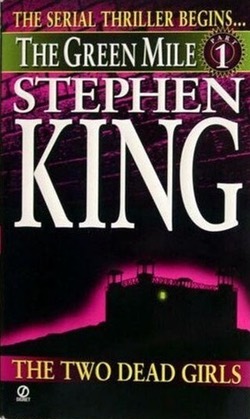 King says it was his foreign rights agent, Ralph Vicinanza, who asked if he’d do a serialized story, prompting King to fuse two ideas he’d been toying with: a story about an electric chair, and a first-person narrative told by a death row trusty who runs a snack cart about an enormous prisoner who makes himself disappear right before his scheduled execution. It took Stephen King 16 months to write The Green Mile, an unusually long time for a man who once said that if he can’t finish a first draft in three months it’s a sign something’s wrong.
King says it was his foreign rights agent, Ralph Vicinanza, who asked if he’d do a serialized story, prompting King to fuse two ideas he’d been toying with: a story about an electric chair, and a first-person narrative told by a death row trusty who runs a snack cart about an enormous prisoner who makes himself disappear right before his scheduled execution. It took Stephen King 16 months to write The Green Mile, an unusually long time for a man who once said that if he can’t finish a first draft in three months it’s a sign something’s wrong.
“I had a story that was sort of struggling for air,” King said in an interview with Neil Gaiman. “That was The Green Mile. And I knew if I did this I had to lock myself into it.” King claims that while writing the story he experienced a kind of serendipity, “…it was all just there for me. You just take it. Everything just fits together like it existed before.” By the time the first chapbook was ready to be released on March 25, he had completed the next two and was writing the fourth, staying comfortably ahead of schedule throughout.
Paul Edgecomb is 104 years old, and the book is his account of his time as supervisor of death row at Cold Mountain Penitentiary back in 1932. Nicknamed The Green Mile, due to the green linoleum floor that leads to the electric chair, Edgecomb runs his death house with a light touch, believing that keeping his staff respectful towards the convicts will avoid trouble. When a giant black man, John Coffey, is convicted of killing two white girls, he’s sent to the Green Mile where he heals Edgecomb’s urinary tract infection with his magical touch, brings another inmate’s trained mouse (Mr. Jingles) back to life, and, after Paul breaks him out of prison one night, he cures the warden’s wife of her brain tumor by sucking it into himself.
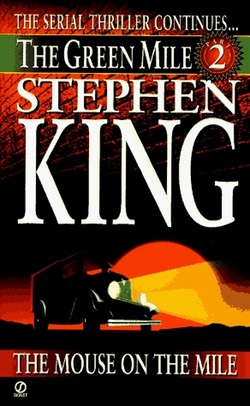 Line by line, The Green Mile is beautifully written. Even an off-the-shelf moment in which Paul talks about shackling convict’s legs to the electric chair and seeing the generic “cold dismay” in their eyes as they realize they’re going to die is suddenly elevated by King’s craftsmanship: “The realization came then…that their own legs had finished their careers. The blood still ran in them, the muscles were still strong, but they were finished all the same…Old Sparky’s clients came to a knowledge of their deaths from the ankles up.” It’s an off-kilter, unexpected way of presenting a shopworn idea, with an almost hardboiled twist at the end. Rose Madder wishes it was written with this kind of elegance.
Line by line, The Green Mile is beautifully written. Even an off-the-shelf moment in which Paul talks about shackling convict’s legs to the electric chair and seeing the generic “cold dismay” in their eyes as they realize they’re going to die is suddenly elevated by King’s craftsmanship: “The realization came then…that their own legs had finished their careers. The blood still ran in them, the muscles were still strong, but they were finished all the same…Old Sparky’s clients came to a knowledge of their deaths from the ankles up.” It’s an off-kilter, unexpected way of presenting a shopworn idea, with an almost hardboiled twist at the end. Rose Madder wishes it was written with this kind of elegance.
But even though the writing is free of generic phrases, the same can’t be said for the main characters. Paul Edgecomb is an old man who’s basically Ralph Roberts from Insomnia, right down to his cantankerous elderly lady sidekick. King only writes one old man at this stage in his career, and he’s a guy who likes slow sweet lovemaking with his age-appropriate spouse, he’s decent, his beliefs are generally liberal, and he’s open-minded. We don’t know which way Paul votes, whether he likes cats, or dogs, or monkeys. We don’t even know what he likes to drink or what his favorite dessert is. His voice is fun to listen to, but this isn’t the spiky, difficult Glen Bateman of The Stand who liked to argue and pontificate. This is Captain Generica.
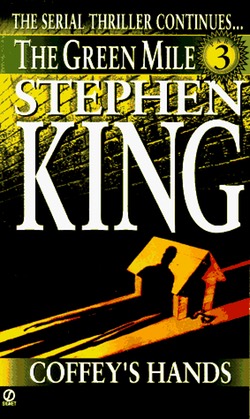 Then there’s John Coffey. This giant black man simply doesn’t want anything. He comes into prison and is fine to be there. He’s sentenced to death and he’s okay with that, too. People ask him what he wants for dinner and he doesn’t want anything in particular. Even worse, Coffey has an “effect” on people that makes them sort of go along with the plot. Whenever King approaches a part of the book that promises to be awkward, Coffey simply generates his “effect” and everyone falls into line. When King needs to get Edgecomb into Coffey’s cell so Coffey can cure his UTI, thereby demonstrating his healing powers, Edgecomb just strolls on in and even his internal monologue reinforces that this makes zero sense: “I was going to open this black giant’s cell, go in, and sit with him,” Edgecomb thinks to himself. “If I was discovered, I might well lose my job even if he didn’t do anything crazy, but I was going to do it, just the same.”
Then there’s John Coffey. This giant black man simply doesn’t want anything. He comes into prison and is fine to be there. He’s sentenced to death and he’s okay with that, too. People ask him what he wants for dinner and he doesn’t want anything in particular. Even worse, Coffey has an “effect” on people that makes them sort of go along with the plot. Whenever King approaches a part of the book that promises to be awkward, Coffey simply generates his “effect” and everyone falls into line. When King needs to get Edgecomb into Coffey’s cell so Coffey can cure his UTI, thereby demonstrating his healing powers, Edgecomb just strolls on in and even his internal monologue reinforces that this makes zero sense: “I was going to open this black giant’s cell, go in, and sit with him,” Edgecomb thinks to himself. “If I was discovered, I might well lose my job even if he didn’t do anything crazy, but I was going to do it, just the same.”
Later, Coffey is broken out of prison by Edgecomb and the other guards to heal the warden’s wife. They show up at the warden’s house unannounced in the middle of the night. As they approached I was thinking, “How on earth are they going to get the warden to let them in?” and braced myself for some unexpected twist. Instead, the warden comes out on his porch, pulls a gun, and then everyone stands around dumbfounded while Coffey generates his effect and strolls on inside. That’s it. A potentially rich dramatic situation defused by authorial hand waving.
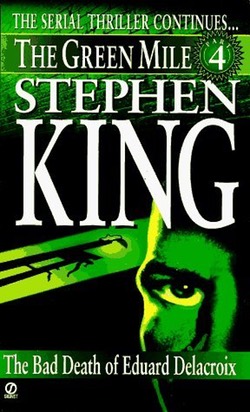 But the biggest problem most people have with this book is John Coffey himself, the Magical Negro whose initials, J.C. tie him a bit too closely to another man who gave his life for others. As King says in On Writing, “A few critics accused me of being symbolically simplistic…And I’m like, ‘What is this, rocket science?’” Coffey is childlike (he’s scared of the dark), he wants nothing more than to cure white people’s problems (their deaths, their urinary tract infections, their pets, their brain tumors), and he’s constantly referred to as “a gift from God.” It doesn’t help that when Paul talks about a spirit in John Coffey that opposes a demonic black shadow he refers to it as “…it was that other spirit—something white, that’s how I think of it, as something white…”
But the biggest problem most people have with this book is John Coffey himself, the Magical Negro whose initials, J.C. tie him a bit too closely to another man who gave his life for others. As King says in On Writing, “A few critics accused me of being symbolically simplistic…And I’m like, ‘What is this, rocket science?’” Coffey is childlike (he’s scared of the dark), he wants nothing more than to cure white people’s problems (their deaths, their urinary tract infections, their pets, their brain tumors), and he’s constantly referred to as “a gift from God.” It doesn’t help that when Paul talks about a spirit in John Coffey that opposes a demonic black shadow he refers to it as “…it was that other spirit—something white, that’s how I think of it, as something white…”
But if we ignore Coffey’s literary context, and the image of Michael Clarke Duncan’s weeping face in the role, and focus solely on what’s on the page, he’s a very different character. He doesn’t die to save the white characters. He isn’t Jesus, whose death redeems the sins of others. He’s also not some hapless chump. When he cures the warden’s wife, he sucks her death into him, then returns to prison and embraces “Wild Bill” Wharton, another convicted murderer who killed the little girls that Coffey has been accused of murdering. Coffey breathes death into Wharton and murders him, dispensing the justice that the white legal system was too dysfunctional to dispense.
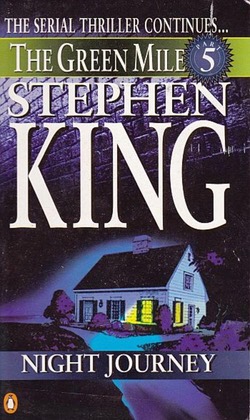 When Coffey begs Paul to let him die in the electric chair, he isn’t being a saint. “I’m rightly tired of the pain I hear and feel, boss,” he says. “I’m tired of bein on the road, lonely as a robin in the rain. Not never havin no buddy to go on with or tell me where we’s comin from or goin to or why. I’m tired of people bein ugly to each other. It feels like pieces of glass in my head.” Dialect aside, that could be any number of blue collar black men living in the Jim Crow South. Coffey doesn’t want to die to save the world, he wants to die because the world is sick and he’s sick of it. Even his last prayer is his own, offering no forgiveness to his executioners, offered without the intercession of a priest.
When Coffey begs Paul to let him die in the electric chair, he isn’t being a saint. “I’m rightly tired of the pain I hear and feel, boss,” he says. “I’m tired of bein on the road, lonely as a robin in the rain. Not never havin no buddy to go on with or tell me where we’s comin from or goin to or why. I’m tired of people bein ugly to each other. It feels like pieces of glass in my head.” Dialect aside, that could be any number of blue collar black men living in the Jim Crow South. Coffey doesn’t want to die to save the world, he wants to die because the world is sick and he’s sick of it. Even his last prayer is his own, offering no forgiveness to his executioners, offered without the intercession of a priest.
Coffey’s death doesn’t save the souls of the white people around him, it damns them. As the switch is pulled, King deploys an astonishing literary device: everyone in the room dies except Coffey. Unlike the previous executions, we don’t get a lingering description of Coffey’s death spasms. Instead, Edgecomb names everyone in the room and tells the reader how each and every one of them will die. Some died months later, some died years later, but in the death chamber it’s their deaths that are lingered over, not Coffey’s.
King has written plenty of Magical Negros before. Mother Abigail in The Stand is one, Dick Hallorann in The Shining is another. But I’m not sure John Coffey is one. He does have a direct connection with the supernatural, and is situated as being closer to God than the white characters in the book, but King doesn’t say which God he’s close to. As King has gotten older, his view of God has gotten more tough-minded and by the time of The Green Mile he’s no longer talking about the New Testament God of flowers and forgiveness, but a punitive Old Testament God. King explores this merciless, inscrutable God much more in Desperation, and by the time he reaches Revival this God has pretty much morphed into Cthulhu: inexplicable, remote, incapable of being judged by human beings. As Edgecomb says:
“I recall how the preachers used to say that God’s eye is on the sparrow, that He sees and marks even the least of His creations. When I think of Mr. Jingles, and the tiny scraps of wood we found in that hole in the beam, I think that is so. Yet this same God sacrificed John Coffey who tried only to do good in his blind way, as savagely as any Old Testament prophet ever sacrificed a defenseless lamb…I think of John saying that Wharton killed the Detterick twins with their love for each other, and that it happens every day, all over the world. If it happens, God lets it happen, and when we say ‘I don’t understand,’ God replies, ‘I don’t care’.”
One of the last things Coffey does is transfer some of his power into Edgecomb, allowing him to outlive everyone in his life and reach the ripe old age of 104. But this isn’t a gift, it’s damnation. Paul remembers every single one of the 78 executions he presided over, he watches his friends die, his wife dies in his arms while the ghost of John Coffey watches him scream and scream. In the end, The Green Mile is Paul’s life, one long, harrowing march to the death chamber. By the time we reach the end of the book he’s begging for death, as desperate as John Coffey to be free of this fallen world. He also knows that, thanks to John Coffey, it’s not coming anytime soon.
Grady Hendrix has written for publications ranging from Playboy to World Literature Today and his latest novel is Horrorstör, about a haunted Ikea.











